

Kells Flour shop. Tipo 00 flour protein content. Pop quiz: What do whipped cream, Nerf footballs, pizza, and Tempur-Pedic mattresses have in common?

That's right — they're all foams. Wait, huh? Pizzas are foams? Baker's Bookshelf (Bread Bakers Guild) Books by Guild Authors Note: Unless otherwise noted, links lead to amazon.com *published in current year By Title.

Artisan bread baking tips: Poolish & biga – Weekend Bakery. What is it?

There are several traditional methods for creating starters for breads. Long Yeast Ferments. Shop - Scotland The Bread. Science of Bread: Bread Science 101. From Chinese baozi to Armenian lavash, bread comes in thousands of forms.
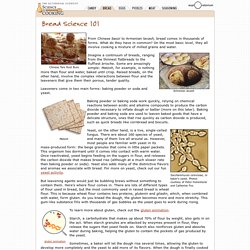
What do they have in common? On the most basic level, they all involve cooking a mixture of milled grains and water. Imagine a continuum of breads, ranging from the thinnest flatbreads to the fluffiest brioche. Some are amazingly simple: Matzoh, for example, is nothing more than flour and water, baked until crisp. Raised breads, on the other hand, involve the complex interactions between flour and the leaveners that give them their porous, tender quality. Leaveners come in two main forms: baking powder or soda and yeast. Baking powder or baking soda work quickly, relying on chemical reactions between acidic and alkaline compounds to produce the carbon dioxide necessary to inflate dough or batter (more on this later). Yeast, on the other hand, is a live, single-celled fungus. But leavening agents would just be bubbling brews without something to contain them.
The Bread Bakers Guild of America. Bread Matters. The Fresh Loaf. Sourdough Companion. Sourdough Bread Formula. Craft Sourdough Bread Formula Jarkko Laine — May 8, 2014 Creating your sourdough starter (or receiving it from a friend or buying it) is just the first step on a long journey with great bread.
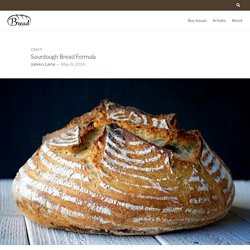
Sourdough Timetables - Sourdough. One of the things that puts people off baking at home is the amount of time that it seems to take.
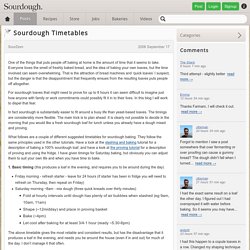
Everyone loves the smell of freshly baked bread, and the idea of baking your own loaves, but the time involved can seem overwhelming. That is the attraction of bread machines and ‘quick loaves’ I suspect, but the danger is that the disappointment that frequently ensues from the resulting loaves puts people off altogether. A list of sourdough websites in the UK, London and the USA. In addition to the information on The Sourdough School site, there are many websites out there offering everything from an in depth exploration of the how’s and why’s of sourdough baking, to ‘how to’ guides and recipes for home bakers.

While the list below isn’t exhaustive, it highlights some of my favourite sites and those I think you might find useful whether you are a beginner sourdough baker, or more experienced and looking to learn more and try new ideas. All list of sourdough websites covering all you need to know from starting a starter to pulling a freshly baked loaf from the oven – Baking Sourdough Bread with a Stiff Starter. Baking in the winter always presents problems here at my house: it’s cold!

Probably not quite the cold you get in other parts of the world but it sure is cold to me, and my starter. Kitchen temperatures are consistently hovering between 68º and 70ºF which really inhibits yeast and bacteria activity. I’ll typically offset this by changing the percentage of mature starter carryover or by heating up the water used in my feedings, but you really want to try to keep your starter around 75º to 80ºF — this is not easy to do when winter is bombarding your area. You just have to make do with the warmest spot you can find in your kitchen, for me this is next to my whisky collection… almost poetic. A short aside… In the winter with all the holiday events and cold weather I find myself baking pies and cakes more and more. Note that frequent starter refreshments will always lead to a lower acidic level (less sour taste) whether you’re working with a stiff or liquid starter. Liquid Starter. The Bertinet Kitchen. BakeryBits - Artisan Bread Baking Equipment. Bread-baking tools and resources for making and enjoying great bread.
Shipton Mill - Home of Organic Flour. Authentic Pizza Dough. Authentic Vera Pizza Napoletana Dough Recipe Ingredients By Volume 4 cups Molino Caputo Tipo 00 flour 1 ½ cups, plus 2 TBL water 2 tsp salt 1/2 tsp dry active yeast By Weight 500gr Molino Caputo Tipo 00 flour 325gr water (65% hydration) 10gr salt 3gr active dry yeast We highly recommend cooking by weight.
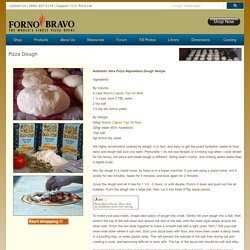
It is fast, and easy to get the exact hydration (water to flour ratio) and dough ball size you want. Mix the dough in a stand mixer, by hand or in a bread machine. Cover the dough and let it rise for 1 1/2 - 2 hours, or until double. To make your pizza balls, shape each piece of dough into a ball. Your pizza balls will need to rest for about an hour to become soft and elastic, so that they can be easily stretched into a thin crust pizza. Percent hydration of pizza dough. Tjkoko, The answer to your question depends mostly on the type or style of pizza that you want to make.
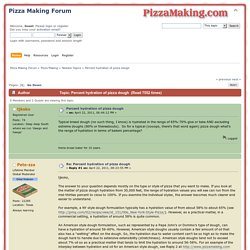
If you look at the matter of pizza dough hydration from 30,000 feet, the range of hydration values you will see can run from the mid-thirties percent to close to 100%. If you examine the individual styles, the answer becomes much clearer and easier to understand. Six Common Mistakes to Avoid When Making Marinara Sauce. (Source: Flickr) Growing up, my Italian Grandma joked that her veins actually pumped marinara sauce. This is a testament to how common and revered marinara sauce is in Italian-American families. Through the years, marinara has become more than just an Italian thing, and is a regular part of meals for families of all sorts of ethnicities. It’s part of our heritage, daily meals, and our very lives. If you’ve tasted a good marinara, you know how spectacular it can be: naturally slightly sweet from the tomatoes, yet seasoned to savory perfection with garlic and herbs.
Crushed Tomato Pizza Sauce - Pizza Quest with Peter Reinhart. Now that we’ve posted two easy to make pizza dough recipes, let’s continue to build our repertoire of fundamental pizza components. During the next few months we’ll post not only these really basic recipes, the essential culinary tool box, so to speak, but also more elaborate recipes and finished dishes, as well as videos with techniques for mixing and shaping dough and such. Recipe: Neapolitan Pizza Dough - Pizza Quest with Peter Reinhart. Note from Peter: I’ve been receiving a lot of requests for a proper VPN Napoletana dough. I’ve posted this previously on the Forno Bravo site, but wanted to be sure I also made it available here on PizzaQuest — especially in light of Brad’s recent post on making Margherita pizzas in two different ovens.
Enjoy!! A true Naples dough uses only flour, water, salt, and yeast.